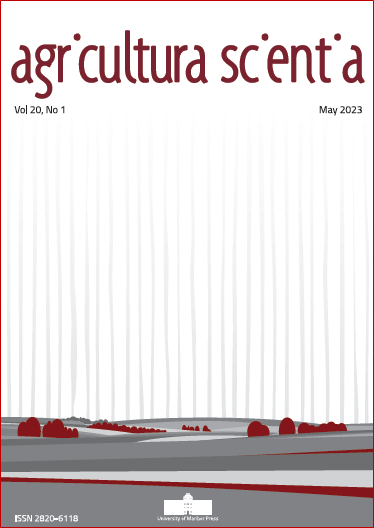Composition of Proteins and Phenolics in the Leaves of Different Mulberry Species (Morus alba L., M. alba × rubra, M. australis Poir., M. nigra L.)
DOI:
https://doi.org/10.18690/agricsci.20.1.3Keywords:
Morus sp., leaves, proteins, phenolic acids, flavonoidsAbstract
The leaves of the mulberry (Morus sp.) have a variety of medicinal, culinary, industrial and agricultural applications. In our study, we compared the protein and phenolic contents of different mulberry species (Morus alba L., M. alba × rubra, M. australis Poir., M. nigra L.) from the mulberry germplasm collection to determine species-specific differences. The possibility of using mulberries as animal feed and for pharmacological purposes was reviewed. Total phenols of all genotypes were analysed using the Folin-Ciocalteu method, while total protein content was determined using the Lowry's method. The individual phenols were analysed by high-performance liquid chromatography with UV/VIS detection. The total protein content ranged from 162.03 mg BSA/g DW (M. australis) to 239.42 mg BSA/g DW (M. alba). Significantly higher contents of total proteins were determined in the leaves of M. alba. The highest mean concentrations of total phenols (21.51 mg GAE /g DW), chlorogenic acid (18.05 mg/g DW), 4-caffeoylquinic acid (4.36 mg/g DW), 5-p-coumaroylquinic acid (2.01 mg/g DW), quercetin glycoside (0.74 mg/g DW) and kaempferol acetyl hexoside (4.42 mg/g DW) were determined in M. alba × rubra and M. nigra. In contrast, white mulberry (M.
alba) genotypes contained on average the most rutin (2.63 mg/g DW) and quercetin-malonyl-hexoside (1.59 mg/g DW). It can be concluded that the leaves of the white mulberry are best suited as animal feed due to their high protein content, while the black mulberry and the hybrid M. alba × rubra have pharmacological potential due to their high phenolic content.
Downloads
Downloads
Published
Issue
Section
License
Copyright (c) 2023 Špela Jelen, Andreja Urbanek Krajnc

This work is licensed under a Creative Commons Attribution-NonCommercial-NoDerivatives 4.0 International License.
